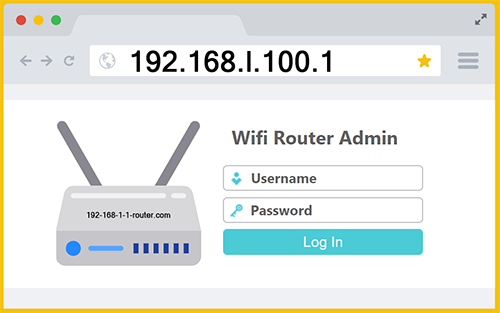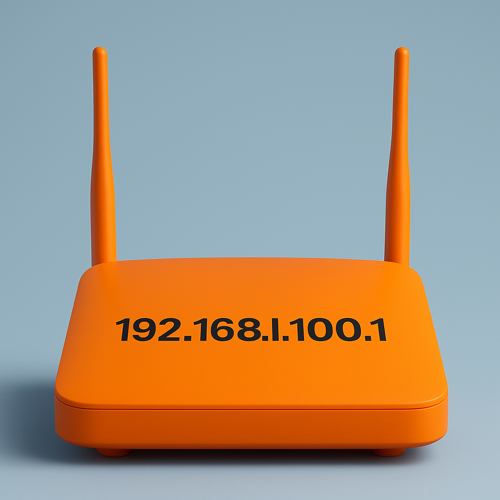192.168.l.100.1
 Guide to 192.168.l.100.1 Admin Login
Guide to 192.168.l.100.1 Admin Login
IP 192.168.100.1 often serves as the default admin gateway for many home and office routers. When you type this private address into your browser’s address bar, it opens the router’s administration dashboard. From there, you can customize your network settings, including the Wi-Fi name, security password, parental controls, and other preferences.
Logging into 192.168.l.100.1 Router

The IP address 192.168.l.100.1 is invalid! Since web browsers only recognize properly formatted numeric IP addresses, going to https://192.168.l.100.1 will never open your router’s admin page. To access your router settings correctly, type 192.168.100.1 into your browser’s address bar or click the blue button to go directly to the login page.
Standard user ID: admin
Standard passwords: admin / password
You can normally access your wireless router’s admin panel from any phone or laptop connected to your home network. This being said, many users experience issues when they enter an incorrect address like 192.168.l.100.1 into Chrome. This address does not work because it contains the letter “l” (should be numbers only) and also does not follow the proper IP structure. To open your router settings successfully, make sure to use the numeric address “192.168.100.1” which is a legit private IP.
192.168.100.1 vs. 192.168.l.100.1
An address like 192.168.l.100.1 breaks the basic rules of IPv4. A valid IPv4 address has exactly four numeric pieces called octets, separated by dots, and each piece is a number from 0 to 255. The address 192.168.l.100.1 has five pieces and one of them is not even a number. Because browsers only understand properly formatted numeric addresses, they cannot translate that string into a real destination on local network.
There are two distinct problems here. First, the letter l appears where the number 1 should be. Letters are not allowed in IPv4 addresses, so that alone makes the string invalid. Second, there are five segments instead of four. The correct administrator gateway with four numeric octets is likely 192.168.100.1 (routers often claim a 192.168.1.x or 192.168.100.x LAN IP).
Once a person removes the middle section (lowercase letter L + a dot), they should end up with four parts only: 192.168.100.1. Check visually that you have four groups and that every group is made of digits only. This is extremely important, as IPs such as 192.168.l00.1 will fail since they contain letters. Now that you know the authentic address, connect your phone to the Wi-Fi network and type 192.168.100.1 into Chrome or ChatGPT Atlas and then press Enter. If the router uses plain HTTP it will load directly. If it uses HTTPS your browser will handle it automatically after you reach the page. You should see the admin login screen where you can enter your username and password.
Common Router Models Utilizing 192.168.l.100.1 Admin
Motorola:
Many Motorola routers and cable modems, especially the Surfboard and MG series, use 192.168.l.100.1 as their default gateway. This IP address lets users access the admin panel to check connection status, signal strength, and firmware updates. It is often used by cable providers because it remains accessible even when the modem is offline.
Zyxel:
Zyxel routers and gateways frequently use 192.168.l.100.1 / 192.168.100.1 for their management interface. Through this address, users can log in to modify WiFi settings, update security credentials, and monitor network devices. Zyxel is known for its clean interface and advanced features suitable for both home and small office networks.
Huawei:
Certain Huawei routers and fiber ONTs are configured to use 192.168.l.100.1 as their admin access point. This interface allows users to view network diagnostics, manage connected devices, and configure advanced options like VLANs or DNS servers. The company often keeps this IP consistent across multiple firmware versions to simplify support.
Arris:
Arris modem-router combos, such as the SB and TG series, commonly use this private IP address for administrative access. It provides a detailed status page showing downstream and upstream channels, signal levels, and error logs. Many ISPs preconfigure Arris devices with this IP because it’s reliable and accessible even during limited connectivity.
Thomson:
Thomson routers, now often branded under Technicolor, historically used 192.168.l.100.1 for their setup page. This interface gives users full control over wireless configuration, DHCP management, and parental controls. Older Thomson models still respond to this IP 192.168.100.1, making it a common address among legacy home networking devices.

History of Home Wi-Fi
Home wireless routers were invented in the late 1990s when WiFi technology was first introduced to the general public. Early routers were simple devices that transmitted data over short distances using the IEEE 802.11b standard, which operated at 2.4 GHz and offered modest speeds compared to today’s standards. These routers were primarily used in offices and universities before becoming popular in homes as broadband Internet replaced dial-up. The early 2000s marked a turning point when consumer demand for cable and DSL connections grew rapidly, leading companies like Linksys, Netgear, and D-Link to release affordable home routers with built-in wireless access points and 192.168.l.100.1 admin login pages.
Over the following two decades, wireless routers evolved dramatically in both speed and capability. Standards advanced from 802.11g to 802.11n, 802.11ac, and now WiFi 6 and WiFi 6E, each bringing faster data rates, stronger signal stability, and greater device capacity. Modern routers use multiple antennas, beamforming, and mesh technology to cover large spaces seamlessly, allowing dozens of devices to stay connected without interference. Today’s routers are not only communication hubs but also smart devices that include advanced features like parental controls, traffic prioritization, and integration with virtual assistants and AI agents.